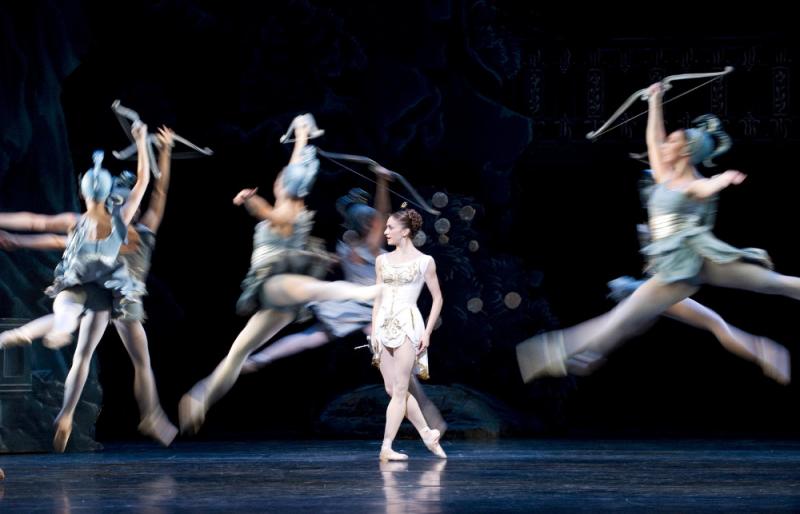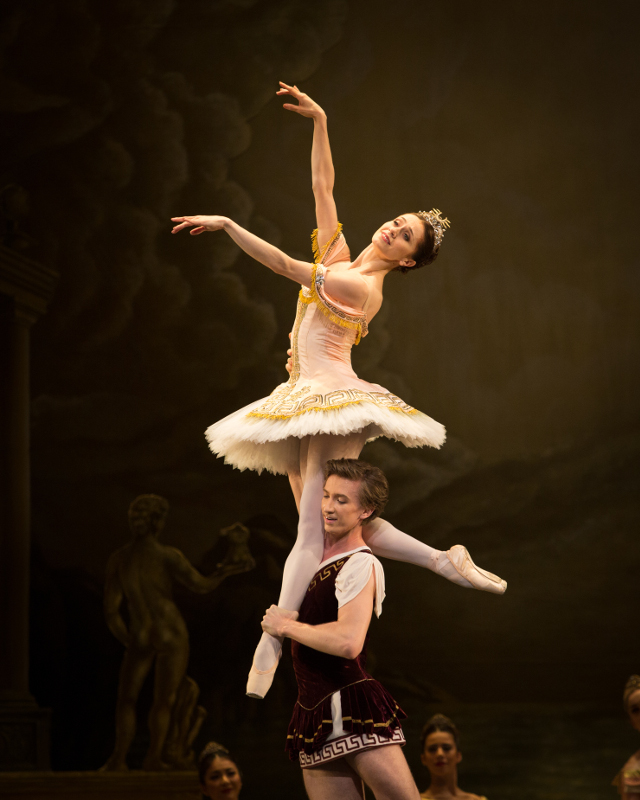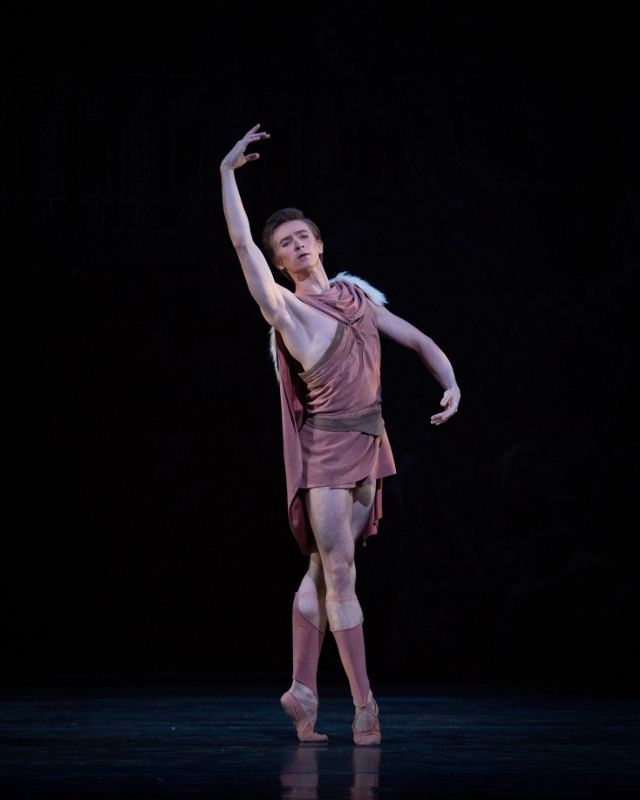Sylvia, Royal Ballet review - Ashton rarity makes a delicious evening | reviews, news & interviews
Sylvia, Royal Ballet review - Ashton rarity makes a delicious evening
Sylvia, Royal Ballet review - Ashton rarity makes a delicious evening
Marianela Nuñez and Vadim Muntagirov sparkle as arcadian lovers

On paper, the appeal of a Sylvia revival is questionable. If even the choreographer (Frederick Ashton) wasn't sure his 1952 original was worth saving for posterity, do we really want to watch a 2004 reconstruction posthumously pieced together from rehearsal tapes?
Sylvia's appeal is enormously boosted by its Delibes score, which is richly colourful and melodic: a delight to the ears all the more potent for being much less frequently heard than many far inferior ballet scores. Hamburg Ballet's conductor Paul Hewett gave a thoroughly engaging account of it with the ROH orchestra last night, not afraid to lean in to the full emotional and dramatic range of the music, but astute enough to hold back from bombast and melodrama. No matter how daft the action on stage is at any given moment, the ever-fresh, stylish merriment of the score redeems it.

With this ardently romantic spirit giving life to the story, one can smile on as the plot and the choreography loop around in swirls of baroque extravangance, complete with naiads, dryads, sylvans, fauns and peasants, oh my... Set and costumes (originally by Christopher and Robin Ironside; updated by Peter Farmer) continually verge on the hopelessly camp, and tip over where the villain of the piece, Orion (Thiago Soares), is concerned. He is presented as a glowering, bearded Turk with an enormous spear (wink, wink) and – compounding orientalism with crimes against fashion – lilac velour harem pants. Poor Soares can do little with this hammy part but grin and bear it.

The choreography is unmistakeably Ashton in its preocupation with fluttery petit allegro and fussy changes of direction. On Nuñez, Muntagirov (pictured above left), Zuchetti and a handful of other dancers (Itziar Mendizabal as Diana, James Hay as a goat, David Yudes as a slave, Fumi Kaneko as Terpsichore) the Ashton style is a balletomane's nerdy delight of frou-frou technicality, and makes an engaging contrast to Russian grandiosity we see in Sylvia's dotty, 19th century ballet relations like Le Corsaire. But unfortunately the choreography gravely challenged many supporting dancers, who not only struggle to convey the Asthon style in port de bras and épaulement (some, like Tierney Heap, don't seem to know where to begin), but look permanently at risk of dropping out altogether. This is a real shame, for not only does it mar an otherwise thoroughly engaging production, but it is rather a poor show if even the Royal Ballet, Ashton's home company, cannot train its dancers to execute his choreography properly.
Focus not on the naiads, dryads, sylvans, fauns, muses et al, then, but on a charming love story, an arcadian setting, and that utterly lovely score. Gritty realism it ain't, but it sure is a delicious evening at the theatre.
- The Royal Ballet perform Sylvia at the Royal Opera House to 16 December
- Read more dance articles on theartsdesk
rating
Share this article
Add comment
The future of Arts Journalism
You can stop theartsdesk.com closing!
We urgently need financing to survive. Our fundraising drive has thus far raised £33,000 but we need to reach £100,000 or we will be forced to close. Please contribute here: https://gofund.me/c3f6033d
And if you can forward this information to anyone who might assist, we’d be grateful.

Subscribe to theartsdesk.com
Thank you for continuing to read our work on theartsdesk.com. For unlimited access to every article in its entirety, including our archive of more than 15,000 pieces, we're asking for £5 per month or £40 per year. We feel it's a very good deal, and hope you do too.
To take a subscription now simply click here.
And if you're looking for that extra gift for a friend or family member, why not treat them to a theartsdesk.com gift subscription?
more Dance
 Help to give theartsdesk a future!
Support our GoFundMe appeal
Help to give theartsdesk a future!
Support our GoFundMe appeal
 Balanchine: Three Signature Works, Royal Ballet review - exuberant, joyful, exhilarating
A triumphant triple bill
Balanchine: Three Signature Works, Royal Ballet review - exuberant, joyful, exhilarating
A triumphant triple bill
 Romeo and Juliet, Royal Ballet review - Shakespeare without the words, with music to die for
Kenneth MacMillan's first and best-loved masterpiece turns 60
Romeo and Juliet, Royal Ballet review - Shakespeare without the words, with music to die for
Kenneth MacMillan's first and best-loved masterpiece turns 60
 Vollmond, Tanztheater Wuppertal Pina Bausch + Terrain Boris Charmatz, Sadler's Wells review - clunkily-named company shows its lighter side
A new generation of dancers brings zest, humour and playfulness to late Bausch
Vollmond, Tanztheater Wuppertal Pina Bausch + Terrain Boris Charmatz, Sadler's Wells review - clunkily-named company shows its lighter side
A new generation of dancers brings zest, humour and playfulness to late Bausch
 Phaedra + Minotaur, Royal Ballet and Opera, Linbury Theatre review - a double dose of Greek myth
Opera and dance companies share a theme in this terse but affecting double bill
Phaedra + Minotaur, Royal Ballet and Opera, Linbury Theatre review - a double dose of Greek myth
Opera and dance companies share a theme in this terse but affecting double bill
 Onegin, Royal Ballet review - a poignant lesson about the perils of youth
John Cranko was the greatest choreographer British ballet never had. His masterpiece is now 60 years old
Onegin, Royal Ballet review - a poignant lesson about the perils of youth
John Cranko was the greatest choreographer British ballet never had. His masterpiece is now 60 years old
 Northern Ballet: Three Short Ballets, Linbury Theatre review - thrilling dancing in a mix of styles
The Leeds-based company act as impressively as they dance
Northern Ballet: Three Short Ballets, Linbury Theatre review - thrilling dancing in a mix of styles
The Leeds-based company act as impressively as they dance
 Best of 2024: Dance
It was a year for visiting past glories, but not for new ones
Best of 2024: Dance
It was a year for visiting past glories, but not for new ones
 Nutcracker, English National Ballet, Coliseum review - Tchaikovsky and his sweet tooth rule supreme
New production's music, sweets, and hordes of exuberant children make this a hot ticket
Nutcracker, English National Ballet, Coliseum review - Tchaikovsky and his sweet tooth rule supreme
New production's music, sweets, and hordes of exuberant children make this a hot ticket
 Matthew Bourne's Swan Lake, New Adventures, Sadler's Wells review - 30 years on, as bold and brilliant as ever
A masterly reinvention has become a classic itself
Matthew Bourne's Swan Lake, New Adventures, Sadler's Wells review - 30 years on, as bold and brilliant as ever
A masterly reinvention has become a classic itself
 Ballet Shoes, Olivier Theatre review - reimagined classic with a lively contemporary feel
The basics of Streatfield's original aren't lost in this bold, inventive production
Ballet Shoes, Olivier Theatre review - reimagined classic with a lively contemporary feel
The basics of Streatfield's original aren't lost in this bold, inventive production

Comments
Totally agree. I was there
Even if it’s a review -
Is it? It might also help a
What Dr. Weibye has to say